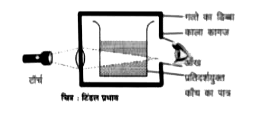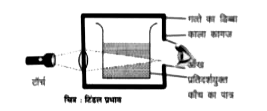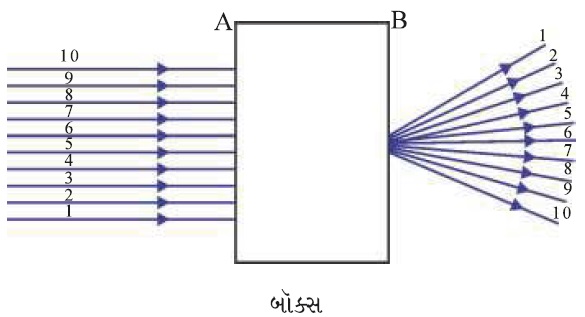A group of students took an old shoe box and covered it with a black paper from all sides. They fixed a source of light (a torch) at one end of the box by making a hole in it and made another hole on the other side to view the light. They placed a milk sample contained in a beaker/tumbler in the box as shown in the Figure. They were amazed to see that milk taken in the tumbler was illuminated. They tried the same activity by taking a salt solution but found that light simply passed through it ?

(a) Explain why the milk sample was illuminated? Name the phenomenon involved.
(b) Same results were not observed with a salt solution. Explain.
(c) Can you suggest two more solutions which would show the same effect as shown by the milk solution?
(a) Milk sample is a colloidal sol also called emulsion. It got illuminated because of the scattering of light on passing through it. The phenomenon is known as Tyndall effect.
(b) The salt solution is a true solution and not a colloidal solution. It will not show any Tyndall effect.
(c ) A solution of sulphur in water and a solution of starch in water.
Topper's Solved these Questions
- BOOK - DINESH PUBLICATIONCHAPTER - IS MATTER AROUND US PUREEXERCISE - SAQs23videos
IS MATTER AROUND US PURE
- BOOK - DINESH PUBLICATIONCHAPTER - ATOMS AND MOLECULESEXERCISE - LONG ANSWER QUESTIONS24videos
ATOMS AND MOLECULES
- BOOK - DINESH PUBLICATIONCHAPTER - MATTER IN OUR SURROUNDINGS EXERCISE - (LAQs) Long Answer Questions5videos
MATTER IN OUR SURROUNDINGS
Similar Questions
Suggest separation technique(s) one would need to employ to separate the following mixtures.
(a) Mercury and water
(b) Potassium chloride and ammonium chloride
(c) Common salt, water and sand
(d) Kerosene oil, water and salt01:45View SolutionVeriy by calculating that
a) 5 moles of CO2 and 5 moles of H2O do not have the same mass.
b) 240 g of calcium and 240 g magnesium elements have a mole ratio of 3:502:22View SolutionYou are provided with a mixture of naphthalene and ammonium chloride by your teacher. Suggest an activity to separate them with well labelled diagram
04:30View SolutionBeams of light are incident through the holes A and B and emerge out of box through the holes C and D respectively as shown in Figure. Which of the following could be inside the box ?
02:14View SolutionA beam of light is incident through the holes on side A and emerges out of the holes on the other face of the box as shown in Figure. Which of the following could be inside the box ?
01:31View SolutionA group of students took an old shoe box and covered it with a black paper from all sides. They fixed a source of light (a torch) at one end of the box by making a hole in it and made another hole on the other side to view the light. They placed a milk sample contained in a beaker/tumbler in the box as shown in the Figure. They were amazed to see that milk taken in the tumbler was illuminated. They tried the same activity by taking a salt solution but found that light simply passed through it ?

(a) Explain why the milk sample was illuminated? Name the phenomenon involved.
(b) Same results were not observed with a salt solution. Explain.
(c) Can you suggest two more solutions which would show the same effect as shown by the milk solution?02:31View SolutionA beam of parallel light rays is incident through the holes on one side of a box and emerges out through the holes on its opposite side as shown in the diagram below:

Which of the following could be inside the box?02:06View SolutionA beam of light is incident through the holes on one side of a box emerges out throught holes on its opposite side as shown in the following figure: The box contains:
02:55View SolutionBeams of light are incident through the holes A and B and emerge out of box through the holes C and D respectively as shown in Figure. Which of the following could be inside the box ?
 07:16View Solution
07:16View SolutionA beam of light is incident through the holes on side A and emerges out of the holes on the other face of the box as shown in Figure. Which of the following could be inside the box ?
02:55View Solutionविद्यार्थियों के एक समूह ने जूतों का एक पुराना डिब्बा लिया और उसे चारों ओर से काले कागज़ से ढक दिया। उन्होंने डिब्बे एक सिरे पर उसमें छिद्र करके प्रकाश का एक स्रोत (टार्च) लगा दिया और बीकर/गिलास में रखे नमूने को देखने के लिए दूसरे सिरे पर एक और छिद्र बनाया, जैसाकि चित्र में दिखाया है। उन्हें देखकर आश्चर्य हुआ कि गिलास में लिया गया दूध प्रदीप्त हो गया था। उन्होंने यही क्रियाकलाप नमक का विलयन लेकर किया। लेकिन पाया कि प्रकाश उसे बिना प्रदीप्त किए उसमें से गुजर गया।

(a) समझाइए कि दूध प्रतिदर्श प्रदीप्त क्यों हो गया? इसमें प्रयुक्त परिघटना का नाम दीजिए।
(b) नमक विलयन के साथ समान परिणाम प्राप्त नहीं होते हैं। समझाइए।
(c ) क्या आप ऐसे दो विलयनों के नाम सुझा सकते हैं जो दूध विलयन के समान प्रभाव दर्शाते हैं।02:47View Solutionचित्र 10.3 में दर्शाए अनुसार प्रकाश पुंज किसी बॉक्स के छिद्रों A तथा B से आपपित होकर क्रमश: छिद्रों C तथा D से बाहर निकलते हैं। बॉक्स के भीत निम्नलिखित में से क्या हो सकता है?
(##NCERT_EXM_HIN_SCI_X_C10_E01_006_Q01.png" width="80%">02:50View Solutionविद्यार्थियों के एक समूह ने गत्थे का एक बाक्स लिया तथा इस बॉक्स में एक छिद्र बनाकर एक टार्च लगा दिया तथा दूसरे पार्श्व पर प्रकाश को देखने के लिये एक अन्य छिद्र बना दिया। दूध के नमूने को एक कांच के बीकर में लेकर बाक्स में रख दिय उन्हें यह देखकर आश्चर्य हुआ कि बीकर में लिया गया दूध प्रदीप्त करता है। उन्होंने इस क्रिया कलाप को नमक का विलयन लेकर करने का प्रयास किया परन्तु पाया कि प्रकाश इसमें से सामान्य रुप से निकल जाता है।

यह बताईये दूध क्यों प्रदीप्त हुआ ? तथा इस परिघटना का नाम ।02:11View Solutionविद्यार्थियों के एक समूह ने गत्थे का एक बाक्स लिया तथा इस बॉक्स में एक छिद्र बनाकर एक टार्च लगा दिया तथा दूसरे पार्श्व पर प्रकाश को देखने के लिये एक अन्य छिद्र बना दिया। दूध के नमूने को एक कांच के बीकर में लेकर बाक्स में रख दिय उन्हें यह देखकर आश्चर्य हुआ कि बीकर में लिया गया दूध प्रदीप्त करता है। उन्होंने इस क्रिया कलाप को नमक का विलयन लेकर करने का प्रयास किया परन्तु पाया कि प्रकाश इसमें से सामान्य रुप से निकल जाता है।

नमक के विलयन से समान परिणाम प्रेक्षित नहीं हुए ?01:58View Solutionविद्यार्थियों के एक समूह ने गत्थे का एक बाक्स लिया तथा इस बॉक्स में एक छिद्र बनाकर एक टार्च लगा दिया तथा दूसरे पार्श्व पर प्रकाश को देखने के लिये एक अन्य छिद्र बना दिया। दूध के नमूने को एक कांच के बीकर में लेकर बाक्स में रख दिय उन्हें यह देखकर आश्चर्य हुआ कि बीकर में लिया गया दूध प्रदीप्त करता है। उन्होंने इस क्रिया कलाप को नमक का विलयन लेकर करने का प्रयास किया परन्तु पाया कि प्रकाश इसमें से सामान्य रुप से निकल जाता है।

क्या आप दूध के विलयन द्वारा दर्शाये गये प्रभाव के समान प्रदर्शित करने वाले दो अन्य विलयन के नाम सुझा सकते हैं।02:57View Solutionપ્રકાશનું એક કિરણપુંજ બૉક્સની સપાટી A પરનાં છિદ્રોમાંથી આપાત થઈ બૉક્સની બીજી બાજુની સપાટી B પરનાં છિદ્રો દ્વારા આકૃતિ 10.4માં દર્શાવ્યા પ્રમાણે બહાર આવે છે, તો આ બૉક્સની અંદર નીચે પૈકી શું હોઈ શકે ?
 04:46View Solution
04:46View Solution

